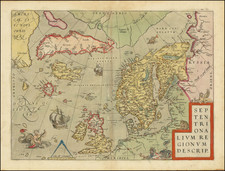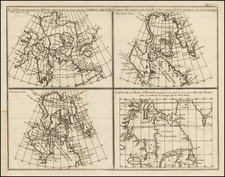Scarce map of the Polar regions of the Arctic, published in 1822 in Edinburgh.
This fascinating map of the North Pole shows a region still in the process of being discovered. There is little detail in western Canada beyond a few notes such as The Sea according to McKenzie or The Sea according to Hearne. The intended course of William Parry's contemporary search for a passage on the northwest end of the Hudson Bay is marked with a dotted line. The coasts of Baffin Bay are littered with place names. Bering Strait is filled with depth soundings.
The map includes the following identified discoveries:
- Alaskan Lands Doubled by the Russians in 1822
- Lands seen by Scoresby in 1817
The Lizars were a Scottish family of engravers and printers who produced many views and maps. Daniel Lizars Sr. (1754-1812) was the son of a shoemaker, but he apprenticed with Andrew Bell, a printer and engraver. Lizars set up his own printworks near St. Giles Cathedral and took on his own apprentices, including George Bartholomew, whose son John would go on to found the important mapmaking firm later know as John Bartholomew & Son Ltd.
Daniel Sr. had three sons: Daniel Jr., John, and William Home. He also had a daughter, Jane Home. Daniel Jr. (1793-1875), the youngest of the boys, apprenticed in his father’s shop alongside George Bartholomew. When his father died in 1812, Daniel Jr. took over much of the business, expanding it and specializing in maps. The company went bankrupt in 1832, however, and Daniel emigrated to Canada.
John Lizars (1792-1860), the middle son, studied medicine and became Professor of Surgery at the Royal College of Surgeons of Edinburgh, as well as senior surgeon at the Royal Infirmary of Edinburgh.
William Home Lizars (1788-1859), the eldest, also apprenticed in his father’s shop. After learning engraving, William entered the Trustees’ Academy to learn under John Graham. He was a skilled painter and artist. When his father died, and after his Daniel Jr. left, he carried on printing and invented a method of etching that looks like wood engraving.











![[Nova Zembla]](https://storage.googleapis.com/raremaps/img/small/75007.jpg)
![[ Hudson Bay ] КАРТА ГУДЗОНСКАГО ЗАЛИВА (Carte de la Baye de Hudson)](https://storage.googleapis.com/raremaps/img/small/100628.jpg)

![[Magellan's Strait] Exquisita & magno aliquot mensium periculo Lustrata et iam retecta Freti Magellanici Facies . . .](https://storage.googleapis.com/raremaps/img/small/94451.jpg)